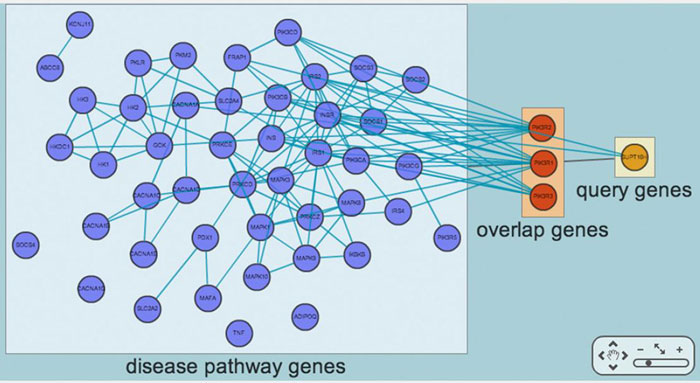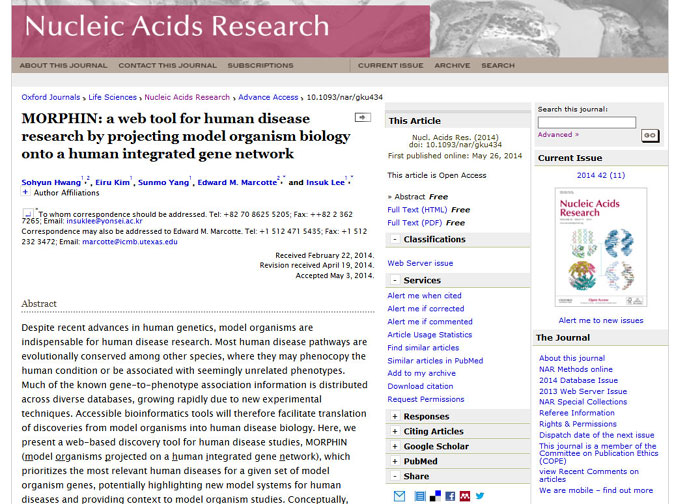-
 Korea.net's 24-hour YouTube channel
Korea.net's 24-hour YouTube channel- NEWS FOCUS
- ABOUT KOREA
- EVENTS
- RESOURCES
- GOVERNMENT
- ABOUT US

A team of researchers from Korea and the U.S. recently developed a big data, animal-based model using biotechnology and IT that can be used to study human diseases.
Professor Lee Insuk of the Department of Biotechnology at Yonsei University led the research team, which included researcher Hwang Sohyun and the University of Texas's Professor Edward M. Marcotte. By using an interaction network of nearly 20,000 human genes, the team developed a web-based system that can predict and trace the signal transfer route of human diseases, such as cancer or diabetes.

In 2012, the researchers jointly developed a human gene social network dubbed "HumanNet," working in collaboration with researchers from the University of Texas. Using HumanNet, they then developed a web-based prediction system dubbed MORPHIN, an abbreviation for "Model Organisms Projected on a Human Integrated gene Network." MORPHIN helped them to discover a new signal transfer route model, which enables the study of human diseases using animal models, like white rats, drosophila flies or eelworms.
Like a social network that shows a network among people, HumanNet maps out 20,000 human genes and their functional networks. By using such a network, MORPHIN can reflect the genes of animal models back to HumanNet, which enables people to study the functional similarity and relations between human diseases and animal models.
In the past, animals such as white rats, drosophila flies and eelworms were used in molecular research of human diseases, as the genes of these animals have similar functions to those of humans. Also, base sequence information was used mainly when examining the function of genes related to human diseases from animal models. Base sequence information, however, is one-dimensional and is not good enough to explain the functions of genes that affect human diseases.

Specifically, the research team reconfirmed that a gene signal route involved in the quiescent behavioral state of caenorhabditis elegans can, in extreme situations, be used as a model for molecular research of type II diabetes in humans. They also proved that the network between excessive homocysteine, a type of amino acid, and cardiovascular disorders can be predicted using caenorhabditis elegans.
Professor Lee Insuk said, “We confirmed the possibility that big data-based systematic biology can become a new paradigm of future medical sciences. This research is expected to boost the modus operandi of research into various human diseases.”
The research was supported by the Ministry of Science, ICT & Future Planning as part of its support for the development of bio medical technology. Research results were published last month in the online edition of the international systematic biology journal, Nucleic Acids Research.

By Yoon Sojung
Korea.net Staff Writer
arete@korea.kr
Professor Lee Insuk of the Department of Biotechnology at Yonsei University led the research team, which included researcher Hwang Sohyun and the University of Texas's Professor Edward M. Marcotte. By using an interaction network of nearly 20,000 human genes, the team developed a web-based system that can predict and trace the signal transfer route of human diseases, such as cancer or diabetes.

Professor Lee Insuk of the Department of Biotechnology at Yonsei University (image courtesy of the Ministry of Science, ICT & Future Planning)
In 2012, the researchers jointly developed a human gene social network dubbed "HumanNet," working in collaboration with researchers from the University of Texas. Using HumanNet, they then developed a web-based prediction system dubbed MORPHIN, an abbreviation for "Model Organisms Projected on a Human Integrated gene Network." MORPHIN helped them to discover a new signal transfer route model, which enables the study of human diseases using animal models, like white rats, drosophila flies or eelworms.
Like a social network that shows a network among people, HumanNet maps out 20,000 human genes and their functional networks. By using such a network, MORPHIN can reflect the genes of animal models back to HumanNet, which enables people to study the functional similarity and relations between human diseases and animal models.
In the past, animals such as white rats, drosophila flies and eelworms were used in molecular research of human diseases, as the genes of these animals have similar functions to those of humans. Also, base sequence information was used mainly when examining the function of genes related to human diseases from animal models. Base sequence information, however, is one-dimensional and is not good enough to explain the functions of genes that affect human diseases.

MORPHIN is a web-based prediction system which helps discover new signal transfer routes. This allows scientists to study human diseases using animal models from white rats, drosophila flies or eelworms. (image courtesy of the Ministry of Science, ICT & Future Planning)
Specifically, the research team reconfirmed that a gene signal route involved in the quiescent behavioral state of caenorhabditis elegans can, in extreme situations, be used as a model for molecular research of type II diabetes in humans. They also proved that the network between excessive homocysteine, a type of amino acid, and cardiovascular disorders can be predicted using caenorhabditis elegans.
Professor Lee Insuk said, “We confirmed the possibility that big data-based systematic biology can become a new paradigm of future medical sciences. This research is expected to boost the modus operandi of research into various human diseases.”
The research was supported by the Ministry of Science, ICT & Future Planning as part of its support for the development of bio medical technology. Research results were published last month in the online edition of the international systematic biology journal, Nucleic Acids Research.

A captured image from the Nucleic Acids Research homepage, an international journal about systematic biology. It published the MORPHIN research results last month.
By Yoon Sojung
Korea.net Staff Writer
arete@korea.kr
Most popular
- Event 'K-Beauty Hang Out' draws hundreds in Philippines
- Ceremony in Seoul inducts 2,641 content creators of Korean culture
- Cultural spring festival Seoul Festa to start on May 1
- 'Mad Max' director impressed by 'cinema-literate' Korean viewers
- President, Romania pledge better defense, nuclear power ties













